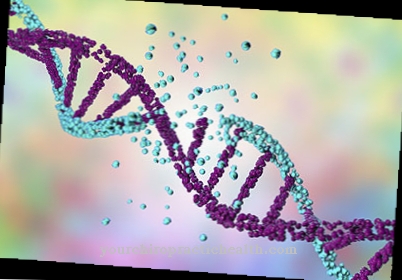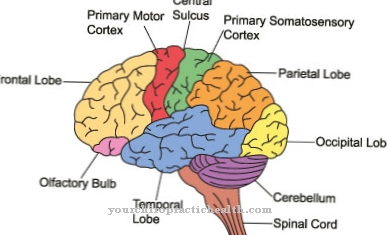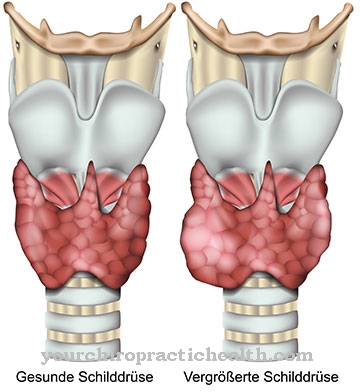A arteriosclerosis, Atherosclerosis is mostly also called Hardening of the arteries designated. In the course of an unhealthy lifestyle, cholesterol, fat and lime (plaque) are deposited in the arteries, which then do not allow enough blood or oxygen to pass through an artery constriction.
What is arteriosclerosis?
The popularly known disease hardening of the arteries is referred to in medicine as arteriosclerosis or atherosclerosis. It is a disease of the blood vessels that carry oxygenated blood away from the heart to supply other organs with oxygen.
This then leads to a narrowing of the vessels. Atherosclerosis is triggered by so-called plaque, which in turn can consist of fats, lime, clots and leg tissue. Over the years, it adheres to the walls of the blood vessels and thus allows less and less blood to flow through them.
This process can already begin in youth, when the person concerned consumes a lot of high-fat and high-sugar meals and does not do much sport. As a result, arteriosclerosis leads to cardiovascular diseases (e.g. coronary heart disease, heart attack, stroke, and thus one of the most common causes of death (approx. 10%) in Germany. Coronary artery diseases and peripheral arterial occlusive disease can also have other consequences , Narrowing of the arteries in the legs and thus loss of the extremities.

causes
Unfortunately, not all causes of arteriosclerosis have yet been clarified. However, there are numerous theories that help explain these diseases. One theory is the lipid theory. Lipid, which is also known as fat, is said to contribute significantly to the formation of arteriosclerosis. Cholesterol (LDL cholesterol) in particular greatly increases the risk of vasoconstriction.
The Cholerstin is converted into fat-containing foam cells, which over time then cause plaques (deposits) on the vessel walls. In addition, other factors belong to the risk groups for arteriosclerosis. Above all, smoking, high blood pressure, elevated cholesterol levels, diabetes mellitus, lack of exercise and obesity can trigger this form of vascular hardening (hardening of the arteries).
Symptoms, ailments & signs
The symptoms of arteriosclerosis usually depend heavily on the exact cause, so that a general prediction is not possible. The patients primarily suffer from severe chest pain. This pain can spread to other regions and thus lead to pain in the limbs and have a very negative effect on the patient's quality of life.
Speech disorders or paralysis can also occur due to arteriosclerosis and lead to restrictions in the movement of the person concerned. Most patients are therefore dependent on the help of other people in their everyday life. If the arteriosclerosis leads to a blood clot, different regions of the body can no longer be supplied with blood, so that a heart attack can continue. In the worst case, the affected person can also die.
Sudden cardiac death or blood poisoning can also occur due to arteriosclerosis and significantly reduce the life expectancy of the patient. Furthermore, many patients also suffer from a so-called smoker's leg or from kidney problems, which can also lead to complete kidney failure. If the arteriosclerosis is severe, it can also lead to fear of death due to the severe chest pain.
course

The course of arteriosclerosis usually begins in adolescence. Fat already accumulates here, damaging the arteries and their inner walls. Over the years, the vessels narrow more and more. More platelets and plaque build up. Which coronary heart disease can result depends on which arteries in which organs are affected. Pre-existing conditions (e.g. heart defects) and the intensity of the hardening of the arteries are also important.
People who smoke or who are overweight can develop secondary diseases of arteriosclerosis more quickly and more severely. However, if atherosclerosis is detected early, most of the damage can be reversed. This usually includes a radical diet and changes in diet as well as a life full of exercise or sport.
If atherosclerosis is not recognized in time or not treated, many complications can arise. On the one hand, as already mentioned, cardiovascular diseases can occur. Coronary heart disease, heart attack and stroke are typical here. However, this can also lead to the loss of the legs or hands, as these are no longer supplied with sufficient blood and die. In order to prevent blood poisoning, these extremities must be amputated. In the worst case, it can also lead to sudden cardiac death.
Complications
Irrespective of the risk factors that favor the development of arteriosclerosis, the penetration of the inner arterial wall with various substances (plaques) can be associated with a number of complications if the arteriosclerosis is not treated. For example, the heart can be affected if one or more coronary arteries are narrowed by sclerosis. When it gradually narrows, there is left-sided chest pain called angina.
If a coronary artery is completely occluded, an immediate heart attack occurs. When atherosclerosis affects one of the two cervical arteries that supply oxygen and nutrients to the head and brain, unpredictable neurological problems arise. Like a heart attack, a stroke occurs when one of the arteries that supply certain areas of the brain with oxygen is blocked by a thrombus.
Further complications can arise if the pelvic and leg arteries are affected by arteriosclerosis. First, circulatory disorders appear in the legs, which develop into peripheral arterial occlusive disease (PAD) as the disease progresses. The disease is also known as intermittent claudication and smoker's leg.
A special type of complication occurs when the renal arteries are affected by arteriosclerosis. This limits the ability of the kidneys to function properly and can lead to complete kidney failure in the end-stage.
When should you go to the doctor?
The suspicion of arteriosclerosis should be clarified medically at the first signs. If symptoms such as cardiac arrhythmias, chest tightness, dizziness or numbness in the limbs suddenly occur, a doctor must determine the cause. This is especially true if the symptoms mentioned do not decrease after a few days at the latest or even worsen over time.
People with diabetes or arterial disease should discuss any abnormal symptoms with their doctor. A blood test will tell whether it is arteriosclerosis or another condition that needs treatment. If there are signs of a heart attack or a stroke, the emergency doctor must be alerted immediately.
There may be an acute arterial occlusion which, if left untreated, can lead to death. For this reason, first aid measures must be carried out until the emergency doctor arrives. A hospital stay is then required for further clarification. As part of this, the cause of the symptoms must be clarified by a cardiologist or internist.
Doctors & therapists in your area
Treatment & Therapy

The therapy or treatment of arteriosclerosis in the early stages can usually be cured if there is a change in diet and exercise. Above all, a healthy lifestyle, without smoking and fatty foods, without alcohol, but with a lot of exercise and sport should be preferred.
There is also the option of reducing arteriosclerosis with medication. However, this method should not replace a healthy lifestyle, as it does not cure the disease, it only delays more severe complications. In this conservative therapy, the same drugs are often used that are also used successfully for other cardiovascular diseases.
If secondary illnesses such as diabetes mellitus or increased blood pressure are already present, these illnesses must also be treated. In the case of severe atherosclerosis, it may also be necessary to widen the narrowing of the blood vessels with an operation. This is where balloon angioplasty is used today. The attending physician pushes a balloon into the affected artery using a catheter and then expands it. In most cases, stents (vascular supports) are then used to rule out renewed vasoconstriction.
If this therapy no longer helps, only a bypass can save the artery and its blood flow.
Outlook & forecast
The prognosis for atherosclerosis depends on where the vascular constrictions and plaques are to be found and the length of the constrictions. Organ damage also plays an important role, and whether patients have already suffered a stroke or a heart attack, for example.
Basically, the earlier the patient changes their lifestyle, the better the prospects. If atherosclerosis only progresses very slowly, serious secondary diseases such as coronary artery disease can be prevented. After all, a third of those affected suffer a heart attack, and another third die from sudden cardiac death. If larger cerebral arteries are affected by atherosclerosis, 20 percent of patients suffer a fatal stroke.
Today plaques are mainly stabilized with modern drugs such as ACE inhibitors or statins. In addition, switching off various risk factors such as smoking, high LDL cholesterol, high blood pressure, stress or lack of exercise improves the prognosis. It must be noted that arteriosclerosis is not a reversible disease and even very mild cases tend to progression. However, the progressive course can extend over years or often even decades.
Aftercare
Atherosclerosis is characterized by the fact that it often goes unnoticed, but can cause great damage to the cardiovascular system and blood vessels. Consistent aftercare is therefore very important. This means that the doctor examines blood lipid levels and the functionality of the heart and circulation in regular check-ups and can thus quickly identify negative changes. This can be done by both the family doctor and the internist, in severe cases with cardiac involvement, the cardiologist as well.
For the patient, aftercare means above all to prevent worsening of the arteriosclerosis through consistent behavior. This includes plenty of exercise, a healthy diet, as well as abstaining from nicotine and excessive consumption of alcohol. Necessary health is also part of aftercare. The aftercare measures can also include participation in sports groups with a corresponding indication or nutritional advice from appropriately trained staff, for example from health insurance companies or adult education centers.
Stress is also a factor that, in conjunction with arteriosclerosis, can lead to complications. Therefore, aftercare is also aimed at reducing stress. Stress reduction is offered by relaxation methods such as autogenic training or progressive muscle relaxation, as well as relaxation methods from the Far East such as yoga, tai chi or qi gong. These procedures have the advantage that in many cases they also have a favorable effect on blood pressure and thus positively support an important factor in combating arteriosclerosis.
You can do that yourself
Since atherosclerosis is a progressive disease, there are many methods that can be used to slow down its course. In this way, everyone who is affected by arteriosclerosis or who is afraid of being affected can actively counteract the pathological changes in the arteries.
In addition to taking any medication that may be needed, those affected have two decisive options to prevent arteriosclerosis from progressing. Sport is an important factor here. Even light exercise in the form of daily walking for a few minutes causes an improvement in blood circulation, cardiac output and the generally perceived strength.
Another important factor is diet. The rule here is that fiber, antioxidants and saturated fatty acids have a positive effect on the further course of arteriosclerosis, while trans fatty acids and tobacco smoke have a negative effect.
It has also been shown that arginine - contained in walnuts, pumpkin seeds and unpeeled rice, among other things - has been shown to protect blood vessels. A supply of this amino acid is therefore recommended.
Further measures that the person affected can take in their everyday life must also be based on any underlying ailments that may promote or trigger arteriosclerosis. In general, stress and obesity must be counteracted in order to maintain arterial health.



























